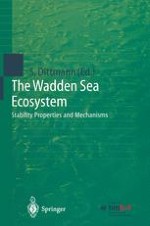1999 | OriginalPaper | Chapter
Grid-Based Modelling of Macrozoobenthos in the Intertidal of the Wadden Sea: Potentials and Limitations
Authors : Volker Grimm, Carmen-Pia Gunther, Sabine Dittmann, Hanno Hildenbrandt
Published in: The Wadden Sea Ecosystem
Publisher: Springer Berlin Heidelberg
Included in: Professional Book Archive
Activate our intelligent search to find suitable subject content or patents.
Select sections of text to find matching patents with Artificial Intelligence. powered by
Select sections of text to find additional relevant content using AI-assisted search. powered by
Grid-based ecological models are a valuable tool in terrestrial ecology which have considerably improved the understanding of many terrestrial systems. Therefore an attempt is made here to apply the grid-based approach to marine benthic soft bottom communities. The concept of patch-dynamics and the theory of mosaic-cycles are the theoretical background which motivated this attempt. Both these concepts are based on the notion of a spatially structured landscape whose spatial and temporal dynamics is ecologically significant. Using two grid-based models we try to find out whether in the intertidal of the Wadden Sea the spatial and temporal dynamics of dominant macrozoobenthic species meet the criteria of the patch-dynamics concepts and the mosaic-cycle theory. The first model takes into account the processes settlement, succession, disturbance events (storms, ice winters) and the dispersal of mussels (Mytilus edulis) into adjacent areas. This first model demonstrates that the frequency of disturbance events and dispersal of M. edulis are the major factors which determine the spatial distribution of the model species. However, the first model has four main methodological deficiencies: (1) the results of the model indicate that the spatial scale to which the model may apply must be rather small (<100xl00m2). (2) For the same reason the model does not reproduce large-scale zonation patterns of benthic communities. (3) Abiotic factors apart from disturbance events which are known to be decisive in the Wadden Sea, e.g. topography, are not taken into account. (4) Interactions between neighbouring spatial units (“cells”) are all but neglected in the model. Thus, based on the topography of a selected part of the Wadden Sea (sandflat “Swinnplate” and surroundings), an advanced second model is developed (TOPOGRID) which only considers the two species Lanice conchilega and M. edulis. This model demonstrates elements of a future model of macrozoobenthos in the intertidal in the Wadden Sea which would be supported by much more expert knowledge than TOPOGRID, more field studies which are designed parallel to the model, and oceanographic models of the current regime. With respect to the theoretical concept which was to be tested with the two models presented here, we conclude that neither the concept of patch-dynamics nor the theory of mosaic cycles are applicable to the Wadden Sea in their original, full meaning.
